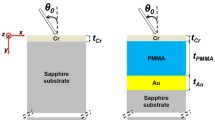Abstract
We could make a thin-film absorbent virtually transparent by enclosing it in a Fabry–Perot cavity. One requirement to realize the phenomenon is that the cavity consists of a pair of mirrors with optimal reflectivity. We calculate the reflectivity to give the highest transmittance through the cavity for various kinds of thin films. An empirical equation to reproduce the optimal reflectivity is given, in which the first term inversely depends on the film thickness and the second term is related to multiplication of the thickness and the dielectric constant of the thin film.



Similar content being viewed by others
References
Egashira, K., Terasaki, A., Kondow, T.: Build-up processes of an optical cavity enclosing an absorbent thin film: computational study by the CIP method. Eur. Phys. J. D 66, 92 (2012)
Terasaki, A., Kondow, T., Egashira, K.: Continuous-wave cavity ringdown spectroscopy applied to solids: properties of a Fabry–Perot cavity containing a transparent substrate. J. Opt. Soc. Am. B 22, 675–686 (2005)
Egashira, K., Terasaki, A., Kondow, T.: Infrared spectra of organic monolayer films in a standing wave measured by photon-trap spectroscopy. J. Chem. Phys. 126, 221102 (2007)
Egashira, K., Terasaki, A., Kondow, T.: Photon-trap spectroscopy applied to molecules adsorbed on a solid surface: probing with a standing wave versus a propagating wave. Appl. Opt. 49, 1151–1157 (2010)
Pu, M., Feng, Q., Wang, M., Hu, C., Huang, C., Ma, X., Zhao, Z., Wang, C., Luo, X.: Ultrathin broadband nearly perfect absorber with symmetrical coherent illumination. Opt. Express 20, 2246–2254 (2012)
Kats, M.A., Sharma, D., Lin, J., Genevet, P., Blanchard, R., Yang, Z., Qazilbash, M.M., Basov, D.N., Ramanathan, S., Capasso, F.: Ultra-thin perfect absorber employing a tunable phase change material. Appl. Phys. Lett. 101, 221101 (2012)
Chong, Y.D., Ge, L., Cao, H., Stone, A.D.: Coherent perfect absorbers: time-reversed lasers. Phys. Rev. Lett. 105, 053901 (2010)
Li, S., Luo, J., Anwar, S., Li, S., Lu, W., Hang, Z.H., Lai, Y., Hou, B., Shen, M., Wang, C.: Broadband perfect absorption of ultrathin conductive films with coherent illumination: superabsorption of microwave radiation. Phys. Rev. B 91, 220301 (2015)
Takewaki, H., Nishiguchi, A., Yabe, T.: Cubic interpolated pseudo-particle method (CIP) for solving hyperbolic-type equations. J. Comput. Phys. 61, 261–268 (1985)
Yabe, T., Xiao, F., Utsumi, T.: The constrained interpolation profile method for multiphase analysis. J. Comput. Phys. 169, 556–593 (2001)
Watanabe, S., Kakuta, Y., Hashimoto, O.: Analysis of absorbing characteristics of one-layer EM-absorber using CIP method. IEICE Trans. Electron. E89-C, 51–60 (2006)
Okubo, K., Yoshida, Y., Takeuchi, N.: Consideration of treatment of the boundary between different media in electromagnetic field analysis using the constrained interpolation profile method. IEEE Trans. Antenna Propag. 55, 485–489 (2007)
Kim, K.S., Zhao, Y., Jang, H., Lee, S.Y., Kim, J.M., Kim, K.S., Ahn, J.-H., Kim, P., Choi, J.-Y., Hong, B.H.: Large-scale pattern growth of graphene films for stretchable transparent electrodes. Nature 457, 706–710 (2009)
Nair, R.R., Blake, P., Grigorenko, A.N., Novoselov, K.S., Booth, T.J., Stauber, T., Peres, N.M.R., Geim, A.K.: Fine structure constant defines visual transparency of graphene. Science 320, 1308 (2008)
Lee, C., Wei, X., Kysar, J.W., Hone, J.: Measurement of the elastic properties and intrinsic strength of monolayer graphene. Science 321, 385–388 (2008)
Born, M., Wolf, E.: Principles of Optics, 6th edn. Pergamon Press, Oxford (1980)
Macleod, H.A.: Thin-Film Optical Filters, 2nd edn. Adam Hilger, Bristol (1986)
Acknowledgments
The present study has been supported by the Special Cluster Research Project of Genesis Research Institute, Inc.
Author information
Authors and Affiliations
Corresponding author
Rights and permissions
About this article
Cite this article
Egashira, K. Optimal mirror reflectivity for transparency of a thin-film absorbent in a Fabry–Perot cavity. Opt Rev 22, 888–892 (2015). https://doi.org/10.1007/s10043-015-0144-z
Received:
Accepted:
Published:
Issue Date:
DOI: https://doi.org/10.1007/s10043-015-0144-z




